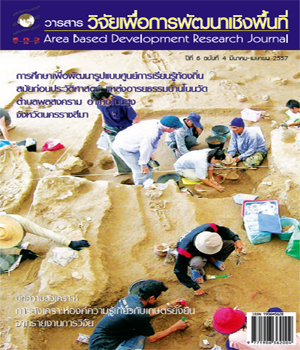ดนตรีพื้นบ้านกับการเป็น แหล่งเรียนรู้ของจังหวัดน่าน
Main Article Content
บทคัดย่อ
การวิจัยครั้งนี้ มีวัตถุประสงค์เพื่อจัดทำฐานข้อมูลองค์ความรู้ด้านดนตรีพื้นบ้านของจังหวัดน่าน ศึกษากระบวนการถ่ายทอดความรู้ด้านดนตรีจากปราชญ์ด้านดนตรีพื้นบ้าน ส่งเสริมการเผยแพร่ดนตรีพื้นบ้านการเป็นเมืองเก่าที่มีชีวิตของจังหวัดน่าน และพัฒนาให้จังหวัดน่านเป็นแหล่งเรียนรู้ด้านดนตรีพื้นบ้าน ใช้ระเบียบวิธีวิจัยทางดนตรีชาติพันธุ์วิทยาในการเก็บข้อมูลภาคสนามในแหล่งเรียนรู้ด้านดนตรีพื้นบ้านในจังหวัดน่านรวม 7 แห่ง ได้แก่ แหล่งเรียนรู้พ่อครูอนันต์ ไชยโพธิ์ แหล่งเรียนรู้บ้านดอนมูลพัฒนา วงดนตรีแสงไฟต๋าม วงดนตรีของโรงเรียนเวียงสา (เสี้ยวดอกขาว) วงดนตรีของโรงเรียนราชานุบาล คณะดนตรีอรุณศิลป์ และคณะดนตรีของสมาคมดนตรีพื้นบ้านน่านโดยพ่อครูคำผายนุปิง โดยการสัมภาษณ์เชิงลึก การสังเกต การจัดเสวนาแลกเปลี่ยนและสังเคราะห์ข้อมูลร่วมกับกลุ่มครูศิลปินพื้นบ้านและนักดนตรี เพื่อให้ได้แนวทางการเผยแพร่และการอนุรักษ์
ผลการวิจัย ด้านฐานข้อมูลองค์ความรู้ด้านดนตรีพื้นบ้านของน่าน ได้แก่ ซอล่องน่าน (ทำนองการขับซอที่เป็นเอกลักษณ์ของจังหวัดน่าน) และวงดนตรีพื้นบ้านสะล้อ ซอ ปิน โดยทำนองซอที่นิยมขับในจังหวัดน่านมีทั้งสิ้น 3 ทำนอง ได้แก่ ทำนองละม้าย ทำนองดาดน่านหรือล่องน่าน และทำนองลับแล (คำว่า “ละม้าย” “ดาดน่าน ล่องน่าน” และ “ลับแล” เป็นชื่อของทำนองที่ใช้ขับซอ หรือขับร้อง) ส่วนเครื่องดนตรีในวงพื้นเมืองสะล้อ ซอ ปิน ได้แก่ สะล้อกลม (สะล้อที่มีคันทวนเป็นทรงกระบอกเหมือนซอด้วง หรือซออู้) หรือสะล้อก๊อบ (สะล้อที่มีการแบ่งช่องเสียงที่คันทวน) และปิน ซึ่งหมายถึง “ซึง” ของล้านนา (เป็นเครื่องดนตรีประเภทดีด มีลักษณะคล้ายกระจับปี่ของทางภาคกลาง) การตั้งเสียงเครื่องดนตรีจะตั้งให้สัมพันธ์กับช่างซอ (ผู้ขับร้อง) เป็นหลักส่วนบทเพลงหลักที่นิยมบรรเลงมี 7 เพลง ได้แก่ กล่อมนางนอน เขมรปากท่อ แม่หม้ายก้อม ฤาษีหลงถ้ำ เสือเลียบค่าย ปั่นฝ้าย และลาวเสด็จ
ด้านกระบวนการถ่ายทอดความรู้ด้านดนตรีจากปราชญ์ดนตรีพื้นบ้าน พบว่าแต่ละแหล่งเรียนรู้มีกระบวนการถ่ายทอดความรู้ด้านดนตรีโดยใช้ระบบโน้ตไทย และระบบโน้ตตัวเลข เพื่อให้ง่ายต่อการจัดการเรียนการสอนและเป็นการบันทึกบทเพลงไว้ไม่ให้สูญหาย นอกจากนั้น พบว่า แต่ละแหล่งเรียนรู้ยังได้รับการสนับสนุนจากรัฐบาลในการจัดกิจกรรมดนตรีพื้นบ้านอย่างต่อเนื่อง ทำให้มีเด็กและเยาวชนได้มีเวทีในการแสดงออก
ด้านการส่งเสริมการเผยแพร่ดนตรีพื้นบ้านการเป็นเมืองเก่าที่มีชีวิตของน่าน ผู้วิจัยได้จัดเวทีเสวนาเรื่อง “แนวทางการอนุรักษ์ และเผยแพร่ดนตรีพื้นบ้านจังหวัดน่าน” โดยเชิญครูศิลปินพื้นบ้านมาร่วมแสดงความคิดเห็น และในที่ประชุมได้เสนอให้มีการส่งเสริมด้านการแสดงดนตรีพื้นบ้าน การส่งเสริมด้านการจัดการเรียนการสอนดนตรีพื้นบ้าน และส่งเสริมด้านการจัดทำเอกสารเผยแพร่
ด้านการพัฒนาให้จังหวัดน่านเป็นแหล่งเรียนรู้ด้านดนตรีพื้นบ้านนั้น ต้องอาศัยความร่วมมือจากหลายฝ่าย ทั้งในเรื่องของการจัดการ และงบประมาณสนับสนุนอย่างต่อเนื่อง จากการประชุมเสวนาได้มีข้อเสนอให้จัดทำหลักสูตรดนตรีพื้นบ้านระยะสั้นจัดทำเอกสารและตำราการสอนดนตรีพื้นบ้านเพื่อใช้ในการจัดการเรียนการสอนให้เป็นไปในทิศทางเดียวกัน และการนำองค์ความรู้เข้าเป็นส่วนหนึ่งในหออัตลักษณ์น่าน
Local Music and Being Learning Resource of Nan Province.
This research aimed to conduct knowledge database of folk music in Nan province, to study the transmission process on folk music of the local experts, and to promote the publicity of folk music for the living ancient city of Nan province and develop Nan province to be the folk music learning resources. The research was conducted by using ethnomusicology method for collecting data in the field study in 7 folk music learning resources in Nan province consisted of Mr. Anan Chaipo learning resource, Ban Don Moon Patthana learning resource, Seang Fai Tam band, Wieng Sa school band (Siew Dok Khao), Rachanuban School band, Aroonsilp Band, Nan folk band foundation by Mr. Khampai Nuping. The data was collected by the in depth interview, observation, and forum and then the data was synthesized with the group of folk artists and musicians to be the guidelines for the publicity and conservation.
The findings of the study revealed thatthe knowledge database of Nan folk music such as Sor Long Nan, Salor, Sor, and Pin folk band. 3 melodies of Sor which were popular in Nan province consisted of Lamai, Dad Nan or Long Nan, and Lablae. The musical instruments in Salor, Sor, and Pin folk band were Salor Klom or Salor Kob and Pin which means Seung of Lanna. The musical instrument will be mainly tuned by Sor musician. 7 main songs which were usually played consisted of Kom Nang Non, Kmer Pak Thor, Mae Mai Kom, Reu See Long Tham, Seu Lieb Kai, Pan Fai, and Lao Sa Det.
The transmission process on folk music of the local expertsrevealed that each learning resource transfer the musical knowledge by using Thai note and numeric note for the easy instruction and songs was also recorded to avoid the disappearance. Moreover, each learning resource was also regularly supported by the government so the children and youth can perform their musical skills.
The promotion of publicity of folk music for being the living ancient city of Nan province was done by inviting the folk artists to share ideas in the forum entitles “ The way to conserve and to publicize of folk music of Nan province”. The suggestion from the meeting was the promotion on the folk music performance, the folk music curriculum, and the publicity of the documents.
The development of Nan province to be the folk music learning resourcesneeded to have the collaboration among many sectors in terms of management, and regular budget support. The recommendations from the meeting were; a short course of the folk music, documents, and textbooks should be developed for the instruction in schools to be taught in the same direction and the knowledge should be put into Nan identity tower.
Article Details
Area Based Development Research Journal values copyright protection and licensing to safeguard author rights and facilitate the appropriate dissemination of research. Our policies ensure openness, accessibility, and attribution. Authors retain copyright ownership, and articles are published under a Creative Commons Attribution License (CC BY), allowing sharing, adaptation, and proper attribution. Authors have the freedom to publish under the CC BY license, granting broad reuse and distribution permissions. The journal supports posting articles on third-party repositories, adhering to institutional and funding restrictions. Author guidelines detail copyright and licensing requirements, empowering authors with knowledge about their rights and responsibilities. These policies cultivate an environment of collaboration, openness, and responsible sharing, benefiting authors and the research community while honoring intellectual property rights.


